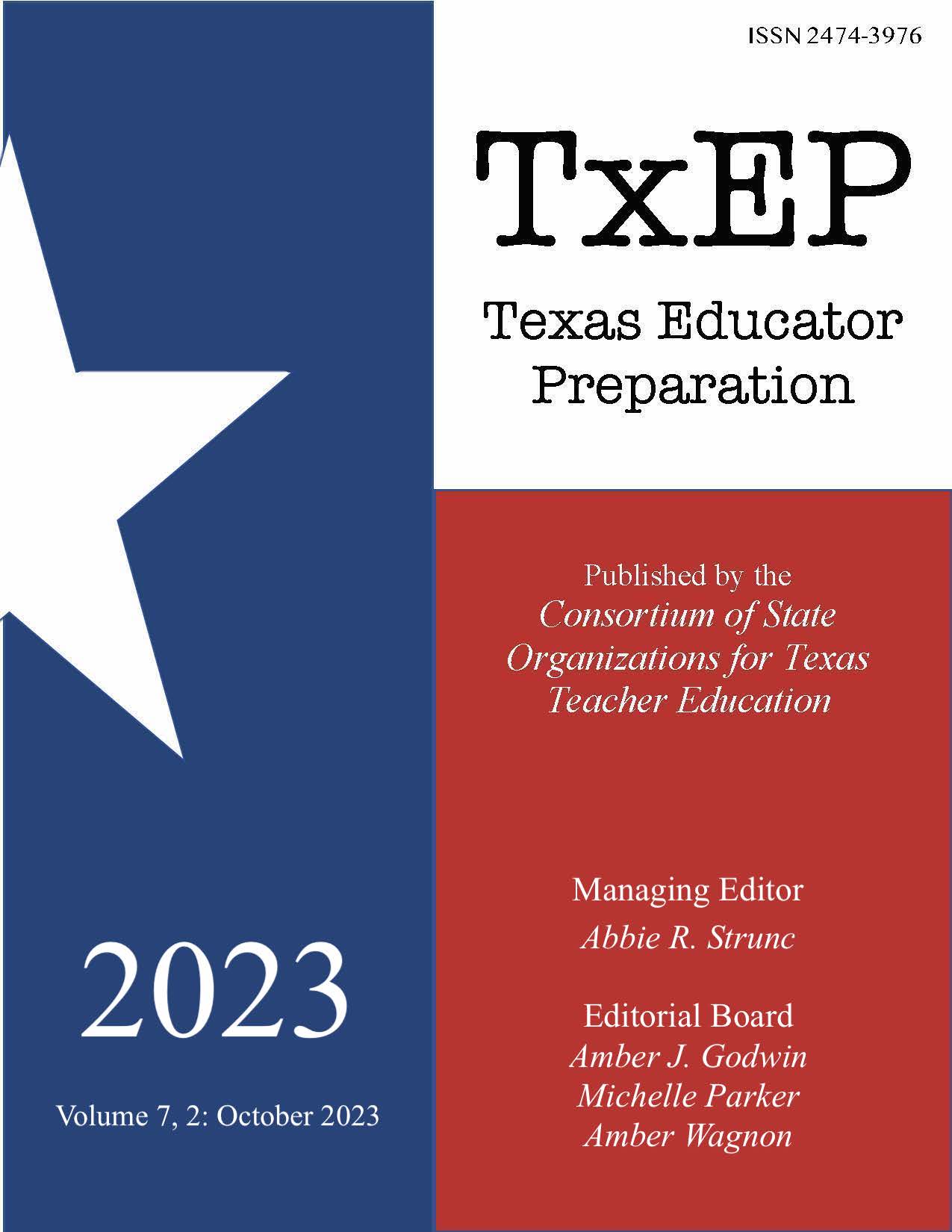The Effectiveness of Co-Teaching in Middle School ELA Inclusion Classrooms
DOI:
https://doi.org/10.59719/txep.v7i2.22Keywords:
inclusion, co-teaching, professional developmentAbstract
The purpose of this study was to investigate the ways in which co-teaching strategies were used in 4th to 8th grade English Language Arts inclusion classrooms. Through the use of a qualitative approach, data collection included interviews, a focus group, and surveys. The following themes were revealed: advantages of co-teaching, weaknesses of co-teaching, and planning. In addition, a theme of inconsistency was discovered. Results indicated that all of the participants used the one teach, one assist approach regularly. Teachers identified problems with implementing co-teaching such as lack of time to plan, classroom support, and professional development.
Downloads
References
References
Anastasiou, D., & Kauffman, J. M. (2011). A social constructionist approach to disability: Implications for special education. Exceptional Children, 77(3), 367-384.
Battaglia, E., & Brooks, K. (2019). Strategies for co-teaching and teacher collaborations. Science Scope, 43(2), 80–83.
Beck, C. T. (2021). Introduction to phenomenology: Focus on Methodology. SAGE.
Buckley, C. (2005). Establishing and maintaining collaborative relationships between regular and special education teachers in middle school social studies inclusive classrooms. In T.E. Scruggs & M. A. Mastropieri (Eds.), Cognition and learning in diverse settings, 18,
-198. Oxford, UK: Elsevier.
Butler-Kisber, L. (2018). Qualitative inquiry: Thematic, narrative, and arts-based perspectives. (2nd Ed.) Sage.
Carlson, L.D. (1996). Co-teaching for integration: An exploratory study. Dissertation Abstracts International, 57(8), 3389A. (UMI No.
AAGNN11685).
Cook, B. G., McDuffie-Landrum, K. A., Oshita, L., & Cook, S. C. (2011). Co-teaching for students with disabilities. In J. M. Kauffman & D. P. Hallahan (Eds.), Handbook of special education. 187-208. New York, NY: Routledge.
Creswell, J.W., Poth. C.N. (2018). Qualitative Inquiry & Research Design Choosing Among Five Approaches. Sage.
Curtin, J.P. (1998). A case study of co-teaching in an inclusive secondary classroom. Dissertation Abstracts International, 60(1), 31A. (UMI No. AAG9917397.
Friend, M. (2015). Welcome to co‐teaching 2.0. Educational Leadership, 73(4), 16–22.
Friend, M. & Cook, L. (2003). Interactions: Collaborative skills for school professionals. (4th Ed.) Allyn and Bacon.
Friend, M. & Cook, L. (2010). Interactions: Collaboration skills for school professionals. (6th ed.). Boston: Pearson Education.
Friend, M. & Cook, L. (2017). Interactions: Collaboration skills for school professionals. (8th ed.) Pearson.
Hazlett, A. (2001). The co-teaching experience joint planning and delivery in the inclusive classroom. Dissertation Abstracts International, 62(12), 4064A. (UMI No. AAI3037002.
Jackson, K. M., Willis, K., Giles, L., Lastrapes, R. E., & Mooney, P. (2017). How to meaningfully incorporate co-teaching into programs for middle school students with emotional and behavioral disorders. Beyond Behavior, 26(1), 11-18.
Luckner, J. L. (1999). An examination of two co-teaching classrooms. American Annals of the Deaf, 144, 24-34.
McLaughlin, M. J. (2010). Evolving interpretations of educational equity and students with disabilities. Council for Exceptional Children. 76(3), 265-278.
Rice, D., & Zigmond, N. (2000). Co-teaching in secondary schools: Teacher reports of development in Australian and American classrooms. Learning Disabilities Research and Practice, 15, 190-197.
Salend, S. J., Johansen, M., Mumper, J., Chase, A. S., Pike, K. M., & Dorney, J. A. (1997). Cooperative teaching: The voices of two teachers. Remedial and Special Education, 18, 3-11.
Scruggs, T. E., Mastropieri, M. A., & McDuffie, K. A. (2007). Co-teaching in inclusive classrooms: A metasynthesis of qualitative research. Council for Exceptional Children, 73(4), 392-416.
Sinclair, A. C., Bray, L. E., Wei, Y., Clancy. E. E., Wexler. J., Kearns, D. M., & Lemons, C. J. (2019). Co-teaching in content area classrooms: Lessons and guiding questions for administrators. NAASP Bulletin, 102(4). 303-322.
Solis, M., Vaughn, S. Swanson, E., & McCulley, L. (2012). Collaborative models of instruction: The empirical foundations of inclusion and co-teaching. Psychology in the schools, 49(5), 498-510. https://doi.org/10.1002/pits.21606.
Tarrant, K. L. (1999). The collaborative implementation of an early literacy curriculum in a full-inclusion primary grade classroom: Co-teachers and students working together to accomplish literacy goals. Dissertation Abstracts International, 60(10), 3599A.
Tatano Beck, C. (2021). Introduction to phenomenology: Focus on methodology. Thousand Oaks, CA: Sage Publications, Inc.
Texas Education Agency, Education Service Center, Region 20. (2018). Co-teaching. A how-to guide. Guidelines for co-teaching in Texas. 1-54.
Thompson, M. G. (2001). Capturing the phenomenon of sustained co-teaching: Perceptions of elementary school teachers. Dissertation Abstracts International, 63(2), 560A. (UMI No. AAI3041129).
Trent, S. C., (1998). False starts and other dilemmas of a secondary general education collaborative teacher: A case study. Journal of Learning Disabilities, 31, 503-513.
Walther-Thomas, C., Korinek, L., McLaughlin, V.L., & Williams, B. T. (2000) Collaboration for inclusive education: Developing successful programs. Needham Heights, MA: Allyn & Bacon.
Weinberg, A., Sebald, A., Stevenson, C.A., & Wakefield, W. (2020). Toward conceptual clarity: A scoping review of co-teaching in teacher education. The Teacher Educator, 55(2), 190-213, DOI: 10.1080/08878730.2019.1657214.
Yüksel, P. & Yıldırım, S. (2015). Theoretical frameworks, methods, and procedures for conducting phenomenological studies in educational settings. Turkish Online Journal of Qualitative Inquiry, 6 (1), 1-20. DOI:10.17569/tojqi.59813.





